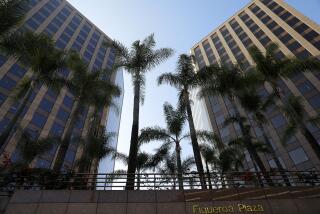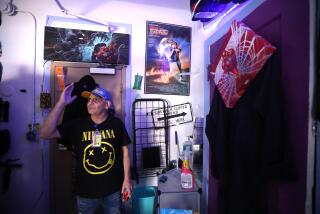FBI investigating possible wrongdoing by inspector on Bel-Air mansion, city investigator testifies

- Share via
A Los Angeles city employee who inspected a colossal mansion under construction in Bel-Air received “items of value” in connection with that work, according to a city investigator.
During a deposition earlier this month, special investigator Randolph Osborne said a city probe had turned up evidence of possible wrongdoing by a Department of Building and Safety inspector. Osborne, who works for the personnel department, said there was “not necessarily … proof of taking bribes, but receiving items of value.”
He testified that he had turned over information to the FBI because he believed “there was a crime potentially committed.”
The details of what Osborne found — including who was involved and what was provided to the building inspector — remain unclear. Under Los Angeles rules, city officials are barred from accepting gifts when it is “reasonably foreseeable” that it could influence them in performing their official work.
Osborne and the building department referred questions for this article to the personnel department, which said it could not comment on employee investigations. The Times obtained information about Osborne’s testimony by reviewing a transcript of his deposition.
The testimony, part of an ongoing fight over the fate of the mammoth house, underscores concerns about the role of the city in the Bel-Air saga.
“It appears to answer the question people have been asking for years: How in the world could this massive illegal structure have been built in full view of city building inspectors?” said attorney George Soneff, who represents neighbors suing Mohamed Hadid, the real estate developer behind the project.
Hadid pleaded no contest last year to criminal charges involving illegal construction on the unfinished mansion in Bel-Air. After the city revoked its permits, prosecutors accused Hadid of building a house that was bigger and taller than allowed and included bedrooms, decks and other areas that the city said were never approved.
Hadid and the project manager, Russell Linch, have stressed that the Bel-Air site was regularly inspected during construction.
“It would have been totally irrational for any person to believe that any of the construction undertaken on the site was not observed and approved by the city inspectors, because the construction was open and notorious,” attorneys representing Hadid argued in a legal filing last year.
Linch told The Times in June that a city inspector was “100% aware of every change and deviation” and told him he could simply get the permits revised afterward. The building department said that had never been its policy.
In the summer, neighbors Beatriz and Joseph Horacek and John and Judith Bedrosian sued Hadid to try to force him to tear down the unfinished building on Strada Vecchia Road. Hadid sued back, accusing Joseph Horacek of attempting to extort millions of dollars from him and then crusading to stop the project when he didn’t get the money.
During that legal battle, Osborne was deposed by Soneff, the attorney representing the neighbors, who quizzed the investigator about a probe into the Bel-Air project.
Soneff asked Osborne if he had ever done an investigation that found that an L.A. building inspector was “either taking bribes or somehow had been illegally influenced” on his or her inspection work, according to the deposition transcript reviewed by The Times.
Osborne said he had and identified the site as the building project on Strada Vecchia, though he added that there was “not necessarily … proof of taking bribes, but receiving items of value.” He later said that the employee involved no longer works for the Department of Building and Safety.
During the questioning, a city attorney stopped Osborne from answering a host of other questions, including who the inspector was, whether the employee had been terminated or disciplined, who had provided the “items of value” to the employee, what the items were and which Building and Safety employees had been interviewed.
Osborne testified that he had met with an FBI agent and provided some documents to him. “I advised the FBI. I met with them. They wanted the case and they’re currently investigating it,” he said during the deposition, according to a transcript.
FBI spokeswoman Laura Eimiller said that the agency does not confirm nor deny whether it is conducting investigations.
Osborne said during his deposition that although he had handed off information to the federal agency, his own investigation was still open because the situation with the building project remained unresolved and “additional information might come in that other employees are involved.”
He testified that the investigation was launched this spring at the request of Frank Bush, the top official at the building department. Bush declined to comment. Soneff said his clients learned about the probe when Osborne and his partner spoke with the Horaceks earlier this year.
Attorney Jeff Costell, who is representing Hadid, said that the real estate developer did not provide anything of value to a building inspector on the project and that Hadid did not know of any of his employees or representatives doing so. Costell added that the city investigation was “news to us.”
“I would never, ever, ever pay an inspector. Not a dime. And nobody has ever approached me,” Hadid told The Times in June.
Linch, the project manager on the Bel-Air mansion, said this week that he was not aware of anything of value being provided to an inspector. “I have no clue about that,” he said.
Soneff, the attorney representing the Horaceks and the Bedrosians, also said the neighbors had not given anything of value to any building inspector examining the project.
The building department has repeatedly been hit by scandals over the past decade: Between 2011 and 2013, three of its inspectors were convicted of accepting bribes after an FBI sting operation.
Earlier this year, city investigators informed the district attorney that they had uncovered fake invoices and nearly $25,000 in payments by the Department of Building and Safety to a consulting company that did not actually exist, according to the department.
Twitter: @AlpertReyes
More to Read
Sign up for Essential California
The most important California stories and recommendations in your inbox every morning.
You may occasionally receive promotional content from the Los Angeles Times.











